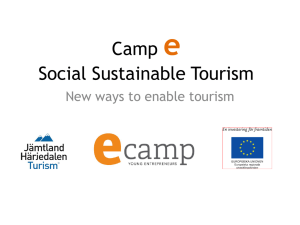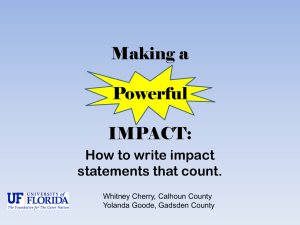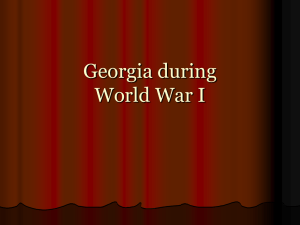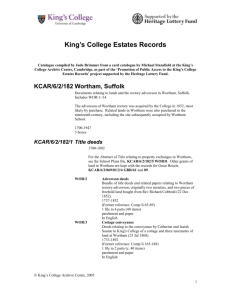Science and Engineering Identity Negotiations for Minorities in SE
advertisement
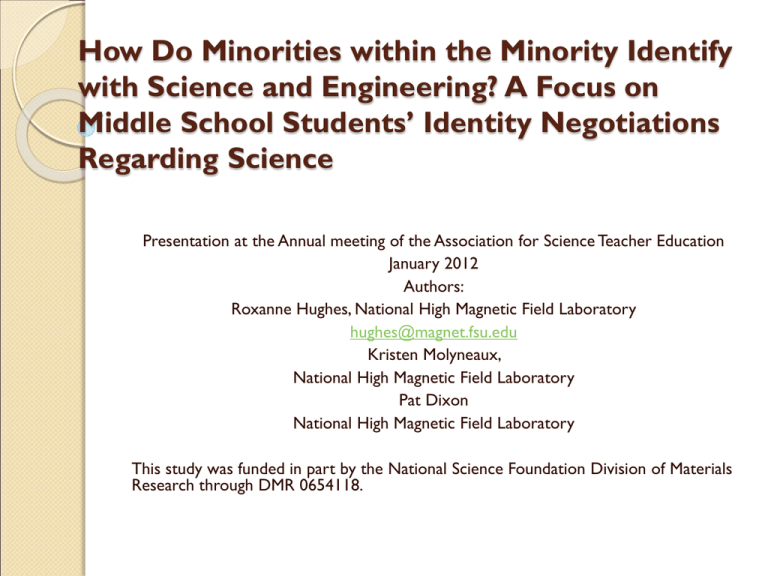
How Do Minorities within the Minority Identify with Science and Engineering? A Focus on Middle School Students’ Identity Negotiations Regarding Science Presentation at the Annual meeting of the Association for Science Teacher Education January 2012 Authors: Roxanne Hughes, National High Magnetic Field Laboratory hughes@magnet.fsu.edu Kristen Molyneaux, National High Magnetic Field Laboratory Pat Dixon National High Magnetic Field Laboratory This study was funded in part by the National Science Foundation Division of Materials Research through DMR 0654118. Issue Identity is the story that we each create for ourselves (Polman & Miller, 2010). Research indicates that one’s identity affects their interests, motivations, and beliefs (Brickhouse, Lowery, & Schultz, 2000; Carlone, 2002; Carlone, 2003; Gee, 2000-1; Painter, Jones, Tretter, & Kubasko, 2006). Identity is also extremely personal (Wortham, 2004). Therefore, qualitative research can help to highlight the individual trajectories of identity formation as well as indicate the patterns of identity formation as they occur within science. Middle School focus Middle school is crucial time when identity formations are occurring, particularly in academic disciplines (Tan & Calabrese Barton, 2008) Time when students try on different identities as they try to form their own view of themselves (Brickhouse, Lowery, & Schultz, 2000). School science can reproduce stereotypes of science (i.e. Albert Einstein) (Carlone, 2004) Informal Educational Programs can address perceptions and expose students to real SE professionals in ways that school science cannot (Watermeyer & Stevenson, 2010) Underrepresentation in SE Research suggests that this is due, in part, to minority students’ inability to fully identify with science and engineering (AAUW, 2010; Carlone, 2003; Olitsky, 2006; Tan, Calabrese-Barton, 2008) Women and minority students often view STEM fields as unwelcoming because of the low numbers of female and minority role models (AAUW, 2010; Brickhouse et al., 2000; Carlone, 2002; Jayaratne et al., 2003; Spielhagen, 2008). ◦ Women represent less than 1/3 of SE degrees and careers (NSF, 2007) ◦ This number is significantly lower for minority women and men (NSF, 2007) Study Focus This study focuses on middle school students’ science identity formations before and after their participation in summer science camps. The participants were part of either a coed science/engineering camp (CESC) or an all-girls science/engineering camp (AGSC). Both camps were similar in that they exposed students to scientists and engineers and the work that they do. Research Questions 1. 2. How do middle school students who are interested in SE fields negotiate their science identities? How does exposure to SE professionals affect students’ science identity negotiations? Participants Two camps summer of 2010 ◦ All-girls Science Camp (AGSC) ◦ Co-ed Science Camp (CEC) Both camps introduced participants to scientists and engineers and their careers AGSC provided broader exposure CEC focused on sustainable engineering Students were selected based on level of interest (application) and teacher recommendation Conceptual Framework: Identity Trajectories within a Community of Practice Wortham’s concept of social identification (2004; 2006) ◦ Wortham defines social identification as occurring when individuals and/or groups are “publically recognized” as “categories of people” (2004, p 716). ◦ Wortham’s concept of social identification has multiple layers (2006). ◦ Models of identity are sociohistorical in that they “emerge over decades and centuries” (2006, p 7). And local in that local practices and categories contextualize them ◦ local identities can be affected by historical identities as well. Individual trajectories of social identity can draw from familiar sociohistorical models, which Wortham also refers to as metapragmatic models (2006). ◦ Context is important in that pivotal events can help to solidify social identity but these require other events that reaffirm the imposed and/or accepted social identity Camps perceived as community of practice within SE (Lave & Wenger, 1991; Wenger, 1998) Carlone & Johnson’s (2007) concept of identity ◦ how individuals “make meaning of science experiences and how society structures possible meanings” (p 1187). ◦ a strong science identity is defined by competence, performance and recognition over many events. ◦ This “competence” is delivered through their performance in varying contexts. And finally this “performance” needs to be “recognized” by “credible” members of the community of practice. All three of these components can be affected by gender, race, ethnicity, and religious affiliation. Research Mixed methods ◦ Participant observations ◦ Teacher interviews focusing on observations of student’s identity trajectories ◦ Pre and post survey for students Quantitative portion – measured self-efficacy in science and engineering and SE identity (AWE, 2008) Qualitative = VNOS (Lederman et al., 2002) Interviews with selected participants (14) to represent varying ages, races, SE interest level, and SES Community of Practice of the Camps Both CESC and AGSC were the communities of practice for our participants. Students in both camps had to apply for the camp. Acceptance was based on each student’s level of science interest. The camps are structured as safe environments where students were encouraged by teachers and others to embrace and discuss their science/engineering interests. Scientists and engineers volunteered on their own or were approached by the camp teachers to lead tours, activities, or demonstrations for the students. Research results During the tours, the researchers focused on students’ level of interaction and interest as measured through positioning in the group and level of participation in discussion. During activities the researchers were able to observe students’ performances of science and able to gauge whether these were recognized by others, particularly the experts (scientists and engineer volunteers). In regards to the overall effect of the camp on students’ science identity and perception, T-tests indicated that there was a significant positive increase from the pre-mean for all campers and the post-mean in both of these categories. This indicates that the camps were successful in positively influencing the students’ perception of scientists and their science identity. The fourteen students who were interviewed in depth fell into three categories Focus of this study Two students who showed changes in their identity trajectory but represented uniquely different paths And yet even with these positive changes, they still struggled in seeing themselves as scientist. The cause of this struggle was different for each of them. ◦ Alice’s struggle was based on her initial perception that science was nerdy. ◦ Darren’s struggle was based on his idea of intelligence and his perceptions that scientists have a commitment to work above all other things. Pseudonyms have been used for all names. Alice – Cool girl vs scientist Had grudgingly come to AGSC because her mom had told her she “had to something educational over the summer”. Separated herself from others at beginning of camp ◦ Too old for camp ◦ Only student to discuss her boyfriend ◦ “obsessed with makeup” The combination of the sociohistorical model of scientists as nerds appeared to conflict with her own local model as a cool or popular girl who enjoyed playing with makeup and discussing her boyfriend. ◦ Before camp, she expressed views that scientists are nerdy. “When I picture a scientist, I picture someone in a lab coat with a pipette dripping it into a chemical in a test tube.” Alice’s trajectory – Cool girls can be scientists Once she became more exposed to scientists during the camp and to her fellow campers she began to see that “scientists do not always work in lab coats, they can be interested in various things besides just their work, and they can use their imagination during their work” (based on VNOS responses). She also began to see that her peers in the camp were also smart and interested in science, which made her more willing to express her interest. Her trajectory was verified by teacher interview data as well ◦ “By the middle of camp she showed genuine interest in the science we were exploring. She even was actively participating in the activities that were happening.” “[The camp] definitely made me more interested in science. And it gave me an idea… like before I knew that there were careers in science but I didn’t actually know what you could do in science. And now I actually know things that you can actually do. Now I picture a scientist as somebody that has… Okay this changed over this week. But now I picture scientists as somebody who has a passion to discover new things and change the way everybody sees things because they get to do that and it’s like their thing. “ But still not committed – thinking about being a chemist or lawyer Summary Alice provides a good example of a student who originally found it difficult to combine her cool girl local model with her perceived sociohistorical model of scientists as nerds, despite her own good student identity The camp built on her increasing interest in science (after her 8th grade year) by shifting her sociohistorical model of scientists. After the camp she saw how the scientists’ varying identities could fit with her own local model of cool and smart girl. And yet, this improved science identity did not lead to a full commitment to a science career as indicated by her discussion of law as a possible career option. Three possible explanations. ◦ First, the two week time frame for the camp was not enough to affect science career decisions. ◦ Second, students in middle school are too young to fully understand career options and measures of career commitment are impossible at this age. ◦ Third, career commitment may not be as important to positive science identity as simply seeing science and scientists as fitting in with one’s own interests. Darren – In the middle Darren exists in the sociohistorical domain often identified by researchers wherein African American males reject academia or appearing smart/white in order to fit in with the defiant African American male culture (Wortham, 2006). But just like Maurice in Wortham’s (2006) study, Darren did not fully fit in with the conflicting sociohistorical domains of defiant African American male and the oppositional characterization of smart as white. Like Maurice, Darren was somewhere in the middle. Darren attended the pre-International Baccalaureate (IB) middle school in the area but he was not in the IB program ◦ “I’m taking honors, I think, in high school. All my teachers signed off for it. But in middle school, my mom said don’t do any IB classes, cause they sent me a letter saying, to fill it out and send it back to them in sixth grade. My mom was like, it’s going to be too much work, you might as well just take general. So I did. But, math and science classes, they were normal. Nothing special I guess. I think I kinda regret, somewhat.” Limbo trajectory His personality was affected by which group of friends he hangs out with: “My groups of friends. Uhh, I have no one group of friends, you know. I hang out with the general kids (general education), you know ESE (special education), don’t have too many of those. The IB, but most of them, you can’t really group my friends as one type, cause they’re all different. Like if I had, me and my friends right here, I’d go around the school and meet some other friends.You would think I’m a totally different person or something. Because of who I hang around. What we do, depends on who I’m with. I guess, if I’m with, uhh, the ones I’ve known longer we might be doing some kind of sport, or athletic activity. And then, if I was with some of my other friends I didn’t know too much longer, we probably just talk about stuff that intrigues us.” Academic and non-academic interests Enjoys science but it is mainly due to his elementary school teacher He was planning to take honors classes in HS, because he enjoyed challenging himself. Lack of family support for his science interest Afraid to commit to a science career because of the long hours ◦ “Like, most of the scientists here (at the national lab where the camp took place), they would sometimes stay overnight, just to get the job done. And when we were at the power plant, I think some people worked twelve hour shifts, like you know, just to get the job done. And you know, there’s a lot of risk in it because you don’t actually know what’s going to happen sometimes, so. I’m not sure anymore. I like science, but, I think I like a nine to five type job. I wouldn’t mind working later but, I guess twelve hours, and then waking up in the morning, twelve hours again, probably ain’t for me. But uh, I wouldn’t mind doing a science career. I like working with my hands and everything. But for the long hours, yeah, that’s a turn off.” Conflicted in terms of who is successful in science ◦ “I guess the smarter people. Or not really smarter but, maybe people that are more interested in that, and if you’re more interested in something, I’m pretty sure you’re going to be better in it. I would say that, the higher people, the people that make better grades in science.” He described these people as follows: “I say most IB kids are more geared towards scientists, and science fields. Most general people aren’t, you know. They’re probably worried about sports and stuff. Yeah, pretty much that, more like honors and AP classes equal scientists, most general and lower, not.” Summary Darren maintained a trajectory that was somewhere in the middle (swinging back and forth like a pendulum) of two seemingly conflicting sociohistorical domains. His local models also seemed to be manifestations of these two different domains, athletics versus academics, easy road versus hard road. During the camp we did not observe that these two worlds ever came together which could indicate that Darren will eventually have to choose between them, affecting his decision to pursue a science career. Darren could represent the extremely difficult domain crossing that occurs for African American students, particularly males, in their decisions regarding science pursuits (Ong, 2005; Wortham, 2006). Like Alice, Darren may be too young to fully understand the requirements of a science career. But unlike Alice, he seemed to have less of a sense of himself as the type of person who does science, despite being competent in the subject. Discussion Each of our case studies exemplifies the complexities within three students’ science identity trajectories Each of these students existed within specific sociohistorical domains and local domains before camp. For all three of these, these domains appeared to conflict, which affected their abilities to fully identify with science ◦ Alice – could see herself as a scientist, but not fully committed ◦ Darren – limbo status, existing in two apparently nonintersecting trajectories This study does not make predictions about these students’ persistence; rather it describes in detail the conflicts between sociohistorical and local domains that can negatively affect students’ science identity trajectories Conclusion According to Wortham (2006) identity trajectories can only be analyzed within context. For this study we can only describe each of our participant’s trajectories within the 1 to 2 week camp context. This is a small snapshot of a much larger trajectory but it still adds to the research on science identity formation for middle school students. Our research indicates that exposing students to scientists and their work in a social setting can have a positive impact on students’ science identities. This study highlights the individuals that compose that quantitative number and uncovers the struggles individuals still encounter despite positive improvements on survey measurements. This research can help educators, informal education agencies particularly, to identify the intricacies of identity formation for students participating briefly in a community of practice. Future studies could build on this work and improve the conceptual framework regarding science identity formation in middle school students. References American Association of University Women. (2010, February). Why so few? Women in science, technology, engineering, and mathematics (Report). Washington, DC: Author. AWE, 2008. Assessing Women and Men in Engineering website, Retrieved March 3, 2008 (http://www.engr.psu.edu/awe/secured/director/precollege/pre_college.aspx Brickhouse, N.W., Lowery, P., Schultz, K. (2000). What kind of girl does science? The construction of school science identities. Journal of Research in Science Teaching, 37(5), 441-458. Brickhouse, N. W., & Potter, J. T. (2001). Young women’s scientific identity formation in an urban context. Journal of Research in Science Teaching. 38, 965-980. Butler, J. (1999). Gender trouble: Feminism and the subversion of identity. New York, NY: Routledge. Carlone, H. B. (2002). The cultural production of science in reform-based physics: Girls’ access, participation and resistance. Journal of Research in Science Teaching, 41, 392-414. Carlone, H.B. (2003). (Re)producing good science students: Girls’ participation in high school physics. Journal of Women and Minorities in Science and Engineering, 9(1), 17-34. Carlone, H.B. (2004). The cultural production of science in reform-based physics: Girls’ access, participation, and resistance. Journal of Research in Science Teaching, 41(4), 392-414. Carlone, H.B. & Johnson, A. (2007). Understanding the science experiences of successful women of color: Science identity as an analytic lens. Journal of Research in Science Teaching, 44(8), 1187-1218. Chang, K. (2009, November 23). White House pushes science and math education. The New York Times. Retrieved from http://www.nytimes.com Gee, J.P. (2000-2001). Identity as an analytic lens for research in education. Review of Research in Education, 25, 99-125. Harding, S. (1997). Women’s standpoints on nature: What makes them possible? Osiris, 12, 186-200. Hazari, Z., Sonnert, G, Sadler, P.M., & Shanahan, M.C. (2010). Connecting high school physics experiences, outcome expectations, physics identity, and physics career choice: A gender study. Journal of Research in Science Teaching, 47(8), 978-1003. Jayaratne, T.E., Thomas, N.G., & Trautmann, M. (2003). Intervention program to keep girls in the science pipeline: Outcome differences by ethnic status. Journal of Research in Science Teaching, 40(4), 393-414. Kozoll R.H. & Osborne, M.D. (2004). Finding meaning in science: Lifeworld, identity, and self. Science Education, 88(2), 157 – 181. Lave, J & Wenger, E. (1991). Situated Learning: Legitimate Peripheral Participation. New York: Cambridge University Press. Lederman, N.G., Abd-El-Khalick, F., Bell, R.L., & Schwartz, R.S. (2002). Views of nature of science questionnaire: Toward valid and meaningful assessment of learners’ conceptions of nature of science. Journal of Research in Science Teaching, 39(6), 497-521. National Science Foundation. (2007). Women, minorities, and persons with disabilities in science and engineering (NSF07-315). Arlington, VA: Author. Olitsky, S. (2006). Facilitating identity formation, group membership, and learning in science classrooms: What can be learned from out-of-field teaching in an urban school? Science Education, 91, 201-221. doi10.1002/sce.20182 Ong, M. (2005). Body projects of young women of color in physics: Intersections of gender, race, and science. Social Problems, 52, 593-617. Painter, J., Jones, M.G., Tretter, T.R., & Kubasko, D. (2006). Pulling back the curtain: Uncovering and changing students’ perceptions of scientists. School Science and Mathematics, 106(4), 181-190. Polman, J.L. & Miller, D. (2010). Changing stories: Trajectories of identification among African American youth in a science outreach apprenticeship. American Educational Research Journal, 47(4), 878-918. Settlage, J., & Southerland, S.A., (2007). Teaching science to all children: Using culture as a starting point. New York, NY: Taylor & Francis. Spielhagen, F. R. (2008). Having it our way: Students speak out on single-sex classes. In F. R. Spielhagen (Ed.), Debating single-sex education: Separate and equal (pp. 32-46). Baltimore, MD: Rowan & Littlefield. Tan, E. & Calabrese Barton, A. (2008) From peripheral to central, the story of Melanie’s metamorphosis in an urban middle school science class. Science Education, 92(4), 567-590. Wenger, E. (1998). Communities of Practice: Learning, Meaning, and Identity. New York: Cambridge University Press. Wortham, S. (2004). The interdependence of social identification and learning. American Educational Research Journal, 41(3), 715-750. Wortham, S. (2006). Learning identity: The joint emergence of social identification and academic learning. New York: Cambridge University Press. Zerubevel, E. (2008). Islands of meaning. In S. E. Cahill (Ed.), Inside social life (5th ed., pp. 18-23). New York, NY: Oxford University Press. Zuniga, K., Olson, J. K., & Winter, M. (2005). Science education for rural Latino/a students: Course placement and success in science. Journal of Research in Science Teaching, 42, 376402.


